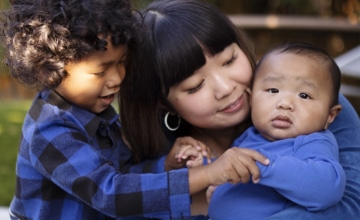Having a child with a personality or temperament very different than your own has its own pluses and minuses. Browse the information and links below to see what your little one is experiencing and learning this month.
IN THIS RESOURCE
- What It’s Like for You
- What It’s Like for Your Child
- What to Expect From Your Child’s Development
- Did You Know…
- Spotlight on: Helping Your Toddler Develop Self-Control
- Let’s Play: Activities That Nurture Bonding and Learning
- What’s on Your Mind?
- Expert Reviewers
What It’s Like for You
Kerri, mother of Madison, aged 31 months, writes:
As much as I love Madison it’s been a little tough at times. I am pretty shy. I’m not that person who walks into a party and knows everybody within 5 minutes. But Madison—oh boy—she is little Miss Personality. She loves people and being around lots of activity. We go to the playground and she is running over and plopping herself into the sandbox, asking to take her new friend home, petting dogs… I think that’s great for her, but it can be stressful for me because it forces me to be more social and outgoing than I’m comfortable with sometimes—like inviting the new friend she made at the playground (and her mom) over to the house for snack. She and I are really different so I am going to have to find ways to adjust.
It’s important to tune in to how you and your child “match” in your temperaments and personal style because it affects how you parent. Keep in mind that there is not a better or worse “fit” between parent and child. Some parents find it easier to have a child who is a lot like them. They can make better guesses about how their child is feeling, what she needs, or what she’s trying to communicate. Other parents find they clash a lot with a child who is very similar to them. They react to characteristics they see in their child that they struggle with themselves.
Having a child with a personality or temperament very different than your own has its own pluses and minuses. For example, you may find it tougher to relate to her, to understand what support she needs, or how she is experiencing a particular situation. But being different can also work well for parents and children. An outgoing parent can help a slow-to-warm-up child learn to feel comfortable in new situations, while the child helps the parent slow down and smell the flowers. The key is to be aware of how you are the same and different so that you can appreciate your child for who she is, separate from you. Then you can nurture her interests and strengths, and support her where she needs help.
What It’s Like for Your Child
Some days it’s easy to say good-bye to Daddy at child care. But today, it was hard. I felt tired and cranky. Daddy’s arms felt so warm and good. I just didn’t want him to go. I was crying and crying and nothing made me feel better. Miss Tanisha said I could paint or she could read me a story. But all I wanted was Daddy. I told him, Don’t go! Don’t go! I sad today. Daddy stay! He said, Are you having trouble saying good-bye this morning? I can stay a few minutes longer if you need some extra time. So we cuddled and rocked in the rocking chair. Then, after a while, he said it was time for him to go. I got tears in my eyes again. He smiled at me and touched my hair and said, It’s time for Daddy to go and for you to play. I know you’re sad. I am sad to leave you too. But you will have a great time here like you always do and Grandma will be here after nap to get you like she always does. Let’s do our special kisses now so you can find your seat for circle time. I knew what that meant. I kiss Daddy’s hand and he kisses mine. Then, when we are missing each other during the day, we can take out our kisses and put them on our cheeks. When we were done, Miss Tanisha took my hand and walked me to my place. She gave me a hug and I gave her a big hug back. She asked me if I wanted to be lunch helper—she knows that’s my favorite job. I said yes, and sat down, and we all sang, Good morning, good morning, good morning to you!
What Your Toddler Is Learning
Social-Emotional Skills:
- To cope with separations as he says good-bye to his dad
- To communicate his feelings and trust that they will be understood and respected by his father
- To build a warm and trusting relationship with his caregiver, Miss Tanisha
- To use special routines (such as the “kissing hand” routine) to cope with his sad feelings about saying good-bye
Language and Thinking Skills:
- To use language to express his thoughts and feelings
- Creativity and imagination as he imagines the kiss on his hand and receives comfort from it
- To be a logical thinker such as when he understands that Miss Tanisha offered him the lunch helper job because it is his favorite. This shows that he is able to see the world from another person’s perspective and think about the “why” behind their actions.
What to Expect From Your Child’s Development
As you read the chart below, keep in mind that development is not a race and that every child grows at her own pace and in her own way. Your child may develop skills faster or slower than indicated below and still be on track. If you have questions or concerns, talk with your child’s health care provider or other trusted professional.
Your Child’s Development From 30 to 36 Months
| What Your Baby Can Do | What You Can Do to Connect With Your Baby |
|---|---|
My body lets me do “big kid” stuff now! |
|
I may be able to:
|
|
I use language to express my thoughts and feelings. |
|
|
|
I am using my new thinking skills to solve problems. |
|
|
|
I can do so many things by myself! |
|
|
|
I am starting to notice similarities and differences in people. |
|
|
|
My friends are very important to me. |
|
|
|
Did You Know…
Children learn compassion, remorse, how to get along with peers, and how to follow rules, when they have the chance to practice what to say and what to do at these moments? Researchers studied a small group of 28 toddlers between 20 and 31 months of age to see how children learned “pro-social” behaviors. Pro-social behaviors were defined as behaviors, like those listed above, that help children become positive, contributing members of their communities. What they found is that children who had the most opportunities to practice pro-social “scripts” and habits—such as being prompted by an adult to comfort another child who was in distress—showed the most pro-social behavior.
What the Research Means for You
We often remind children to “use their words.” But it’s easy to forget that toddlers often don’t have the words or experience to handle many of the more complex situations they encounter in the toddler years. That’s why teaching children how to respond in different situations—what words or behaviors are appropriate—is so important for their social-emotional development. Here are some ways you can build these important learning opportunities into everyday moments:
- Give your child the words—or “scripts”—she needs to develop positive social skills. Look, your friend fell down and bumped his knee. Let’s go ask if he’s okay and see if he wants some ice. Or, You have a new friend in your preschool class. His name is Nathan. Let’s go say hello, and ask Nathan if he wants to play.
- Be a role-model. Your child watches you carefully. When you show respect to others (including him), apologize when appropriate, and show how you are following rules, you have a significant, positive influence on your child.
- Prompt your child to use good manners. Your child may need to be prompted to say I’m sorry after she accidentally steps on another child’s toe at the playground. (Or to say Excuse Me, after that rather loud burp!) But with patient repetition over time, children find their own ways of expressing these kinds of thoughts and feelings.
- Establish a set of “family rules” about how you treat each other that helps your child know what behaviors are important in your family. Keep the list to about five items so your child can understand and come to remember them all. Think about rules like: No hitting or hurting. We help one another. We listen to each other. Talk about these rules and use them in your daily interactions with your children. This helps children see that following rules is part of their everyday lives.
Spotlight on: Helping Your Toddler Develop Self-Control
Self-control is the ability to recognize, express, and cope with strong emotions in ways that are appropriate and acceptable. Developing self-control begins at birth and continues throughout childhood. It is a skill that is critical to children’s school success and overall healthy development. It allows children to cooperate with others, to cope with frustration, and to resolve conflicts. Young children learn these skills through interactions with others and guidance from parents and other caregivers. The process of developing self-control starts very early, for example, when babies stop crying and learn to wait when they hear a parent coming down the hallway to get them after their nap. Children continue working on self-control skills for most of their childhood, and through the teen years—which may come as no surprise to the parents of adolescents! Here is an example of how self-control might look for a 2-year-old:
Julian wants the toy that his friend is playing with. He grabs it. When his friend begins to cry, he slaps his friend and begins to cry himself. Julian’s mother calms him and then helps him return the toy to his friend. She explains that hitting is not okay and gives Julian the words he needs to ask for a turn with the toy. She stays with him and helps him wait for his turn by getting him interested in a toy jack-in-the-box that is nearby. In these everyday moments, this toddler is learning how to manage and express his strong feelings and impulses, to calm himself, and to make acceptable behavioral choices.
Toddlers have minds of their own and strong feelings that they express with gusto. No! becomes a favorite word and a powerful way to assert their independence. At the same time, toddlers can become easily frustrated because there are still many things that they want to do but can’t. Routines are especially helpful now as they make children feel secure at a time when they can feel very out of control.
Even older toddlers are unable to stop themselves from acting on their desires.
The following are strategies that can help them develop self-control:
Give your child opportunities to choose.
This lets her know you value how she thinks about the world and that you trust her to make good decisions. It also gives her a sense of control. Let your child make choices about things like what to play, what to read, or what to have for snack (among two or three healthy snacks you offer). Remember, if a decision is really yours, don’t offer a choice. Say, It’s bed time, not Are you ready for bed? Or, if you really care that her pants and shirt match, offer two shirt choices that both match.
Limit the number of choices.
Too many choices can be overwhelming for a toddler: Do you want cereal or a bagel for breakfast?
Label and recognize your child’s feelings.
Letting children know their feelings are understood helps them calm down and regain control. This doesn’t mean you give in to their demands. I know you are mad that I turned the TV off. It’s okay to be mad but you can’t hit me. You can tell me with your words how mad you are or stomp your feet to show your anger. When you calm down, we can read this book. Naming and recognizing his feelings helps your child learn to manage his emotions. Use short sentences when your child is very upset. When your toddler is having difficulty making a decision or managing her feelings, limit the number of words you use. Too many words can be overwhelming for your toddler and make it harder for her to calm down.
Help your child learn to wait.
Waiting helps children learn self-control. It also teaches them that others have needs, too. Make the wait-time short and give your child something to do in the meantime. Also, playing with friends offers many opportunities to help your child learn to wait, share, and take-turns. With your guidance and lots of practice, your child will be well equipped to work out conflicts with his school pals later on.
Play turn-taking and listening games.
Any game that involves taking turns, whether it is rolling a ball back and forth, racing toy trucks, or feeding a babydoll, helps children develop self-control as they learn to wait for their turn to participate. Listening games, like simple versions of Simon Says or Red Light, Green Light, also help your child listen and follow rules—part of mastering self-control.
Let’s Play: Activities That Nurture Bonding and Learning
It’s a bird, it’s a plane, it’s….Super Kid!!!!
Clip or pin a dish towel to your child’s back to make her very own superhero cape. Go on adventures inside or out as the two of you rescue stuffed animals from sofa-top “trees” or pull dump trucks from couch cushion “quicksand.” What stories does your child come up with as you play? Games like this build logical thinking, language, literacy, and sequencing skills as your child acts out her story. She is also building muscle strength and coordination and as the two of you jump, run, and fly through your very own Gotham.
We took a magic walk and we saw…
With your child, find photos of animals, gardens, houses, and other interesting pictures in magazines. Cut them out and glue to index cards. When you want to go on a “magical” walk, hold up your stack of cards and say, “We took a magic walk and we saw…” and choose a card. See if your child knows the name of that picture. The two of you can move and make sounds like the animal you chose, or pretend to knock on the door of a house, or smell a flower photo. Games like this invite your child to use his growing language skills, as well as his imagination and logical thinking. For example, your child might tell you he wants a banana after he sees a picture of a monkey.
What’s on Your Mind?
1. My 2 ½-year-old goes to child care a few days a week. His teacher has been telling me that my son hits and is very aggressive with the other kids. He’s not talking very much yet, so it’s hard for me to know what is going on with him and to discipline him. What can I do?
Aggressive behavior in toddlers is not uncommon. They have strong feelings that they express in many different ways, often through action. Aggression can be the result of many different things—frustration that they can’t do or have everything they want, difficulty managing strong emotions, recent changes in their lives (new baby, parent on a business trip)—and countless other reasons. Key to effectively addressing the behavior is understanding why your child is feeling angry and “acting out” at this time.
One hypothesis, based on your description of your child, is that his behavior is connected to his language development. By age 2 ½, most children have a growing vocabulary and can string several words together, such as, I want truck! to communicate what they are thinking and feeling. Sometimes children this age don’t have the words, but are able to communicate through gestures (such as pointing) and vocalizations or single words (such as, “Mine!”), which lets others know what they want.
Children who are limited in their ability to communicate with words often use actions to express themselves, like hitting the child who has the truck he wants. In addition, when a child is unable to let others know what he needs, that in itself can be frustrating and lead to aggressive behavior. The classroom environment can also be a factor. For example, sufficient open space, multiples of similar toys, and teacher availability are critical for helping a child learn to wait, use his words, and manage frustration. Spending time in the classroom to see the situation from your son’s point of view may help you determine the next best course of action.
If you are concerned about his language development, you may want to consider seeking an assessment by a speech therapist who can help determine whether your son’s behavior is related to a delay in language development. You can get referrals to a speech therapist from your child’s health care provider or from a local child development center. Typically, a speech therapist will assess a child through play and other activities. You should be an important part of this process—sharing your observations of and ideas about your child (indeed, you know him best)—and be present in the actual session(s). These assessments can be very useful in identifying if your son needs help in developing language and for making a plan to help him learn good communication skills that will hopefully lead to his learning to “use his words” to express his anger in non-aggressive ways.
2. My 2-year-old will go for a week at a time where it seems like he just wants to eat one thing at every meal. For example, we had the all-macaroni week, the all-peanut butter week, the all-applesauce week. What is going on?
These kinds of “food jags” are common in toddlers. While these streaks can be frustrating, and parents may worry that their child isn’t getting adequate nutrition, in most cases, there is nothing to worry about. In fact, when parents are asked to actually record what their child is eating and drinking during these jags, it is often the case that the children are having small amounts of other foods as well as milk and juice.
There could be several reasons for this behavior. A child may have happened upon a new food they truly love and crave it day after day, not unlike some adults! Also, children are creatures of habit—which is why they often like reading the same book each time before nap time. It can be very soothing to a child, especially during a stressful time, to know what to expect, including at mealtime. There are also children who are very sensitive to different tastes and textures and have strong preferences. They feel safe eating the same food and may be more likely to resist trying new foods.
As for how to respond, what you want to avoid is turning mealtime into a battleground that can have lasting, detrimental effects. Keep offering other kinds of foods that might be similar to what he is stuck on, but don’t force it. For example, if your child only wants plain pasta, you can offer whole-wheat pasta or pasta with a tomato sauce for dipping. The fact is that most children will get bored just eating one thing and begin making other choices.
Expert Reviewers
- Terrie Rose, PhD, President and Founder, Baby’s Space
- Ross Thompson, PhD, Professor of Psychology, University of California at Davis
- Robert Weigand, MS, IMH-E, Director, Child Development Laboratory, Arizona State University




